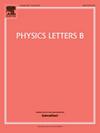Boosted top quark inspired leptoquark searches at the muon collider
IF 4.3
2区 物理与天体物理
Q1 ASTRONOMY & ASTROPHYSICS
引用次数: 0
Abstract
The proposed muon collider presents a promising avenue to explore various classes of beyond the standard model (BSM) particles. In this paper, we investigate the discovery prospects of the scalar leptoquark (sLQ) at a muon collider. We consider two benchmark center-of-mass (C.O.M.) energy scenarios: 5 TeV and 10 TeV. We assume that the LQ decays into a top quark and a muon. The collider analysis for an LQ decaying into a top quark is distinct from that of lighter quarks. A TeV-scale sLQ decaying into a top quark can produce an exotic, boosted fat-jet signature. In addition to the usual searches based on pair production of sLQs, we also examine the single production mode, which depends on the coupling. We demonstrate that systematically combining the pair and single production modes significantly enhances the discovery potential of the sLQ at the muon collider. Our signal topology includes at least one hadronically decaying top fat-jet and two oppositely charged muons, thereby enabling the incorporation of the single production mode. We show that even with single production alone, it is possible to probe sLQs as heavy as 4.5 TeV (9.0 TeV) in the 5 TeV (10 TeV) C.O.M. scenario for couplings.
在介子对撞机中,增强顶夸克激发的轻夸克搜索
提出的μ子对撞机为探索各种超越标准模型(BSM)粒子提供了一条有前途的途径。本文研究了在介子对撞机上发现标量轻夸克(sLQ) S1的前景。我们考虑两种基准质心(c.o.m)能量情景:5 TeV和10 TeV。我们假设LQ衰变成顶夸克和介子。对撞机对LQ衰变成顶夸克的分析不同于对轻夸克的分析。一个tev级的sLQ衰变成顶夸克可以产生一种奇异的、增强的脂肪喷射特征。除了基于slq对产生的搜索之外,我们还研究了依赖于S1tμ耦合的单个产生模式。我们证明了系统地结合对和单产生模式显著提高了在介子对撞机上发现sLQ的潜力。我们的信号拓扑结构包括至少一个强子衰减的顶部脂肪射流和两个相反电荷的μ子,从而使单一生产模式的结合成为可能。我们表明,即使单次生产,在5 TeV (10 TeV) c.o.m方案中,对于O(1)耦合,也有可能探测到重达4.5 TeV (9.0 TeV)的slq。
本文章由计算机程序翻译,如有差异,请以英文原文为准。
求助全文
约1分钟内获得全文
求助全文
来源期刊

Physics Letters B
物理-物理:综合
CiteScore
9.10
自引率
6.80%
发文量
647
审稿时长
3 months
期刊介绍:
Physics Letters B ensures the rapid publication of important new results in particle physics, nuclear physics and cosmology. Specialized editors are responsible for contributions in experimental nuclear physics, theoretical nuclear physics, experimental high-energy physics, theoretical high-energy physics, and astrophysics.
 求助内容:
求助内容: 应助结果提醒方式:
应助结果提醒方式:


